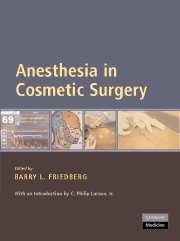Book contents
- Frontmatter
- Contents
- Foreword
- Acknowledgments
- Introduction
- Preface
- List of Contributors
- PART I MINIMALLY INVASIVE ANESTHESIA (MIA)Ⓡ FOR MINIMALLY INVASIVE SURGERY
- 1 Propofol Ketamine with Bispectral Index (BIS) Monitoring
- 2 Preoperative Instructions and Intraoperative Environment
- 3 Level-of-Consciousness Monitoring
- 4 The Dissociative Effect and Preemptive Analgesia
- 5 Special Needs of Cosmetic Dental Patients
- 6 Propofol Ketamine in the UK, Propofol Ketamine Beyond Cosmetic Surgery
- 7 Propofol Ketamine Beyond Cosmetic Surgery: Implications for Military Medicine and Mass-Casualty Anesthesia
- 8 Lidocaine Use and Toxicity in Cosmetic Surgery
- 9 Local Anesthetic Blocks in Head and Neck Surgery
- 10 Local Anesthetics and Surgical Considerations for Body Contouring
- PART II ALTERNATIVE ANESTHESIA APPROACHES IN COSMETIC SURGERY
- PART III OTHER CONSIDERATIONS FOR ANESTHESIA IN COSMETIC SURGERY
- APPENDIX A A Guide to Perioperative Nutrition
- APPENDIX B Reflections on Thirty Years as an Expert Witness
- Index
- References
7 - Propofol Ketamine Beyond Cosmetic Surgery: Implications for Military Medicine and Mass-Casualty Anesthesia
from PART I - MINIMALLY INVASIVE ANESTHESIA (MIA)Ⓡ FOR MINIMALLY INVASIVE SURGERY
Published online by Cambridge University Press: 22 August 2009
- Frontmatter
- Contents
- Foreword
- Acknowledgments
- Introduction
- Preface
- List of Contributors
- PART I MINIMALLY INVASIVE ANESTHESIA (MIA)Ⓡ FOR MINIMALLY INVASIVE SURGERY
- 1 Propofol Ketamine with Bispectral Index (BIS) Monitoring
- 2 Preoperative Instructions and Intraoperative Environment
- 3 Level-of-Consciousness Monitoring
- 4 The Dissociative Effect and Preemptive Analgesia
- 5 Special Needs of Cosmetic Dental Patients
- 6 Propofol Ketamine in the UK, Propofol Ketamine Beyond Cosmetic Surgery
- 7 Propofol Ketamine Beyond Cosmetic Surgery: Implications for Military Medicine and Mass-Casualty Anesthesia
- 8 Lidocaine Use and Toxicity in Cosmetic Surgery
- 9 Local Anesthetic Blocks in Head and Neck Surgery
- 10 Local Anesthetics and Surgical Considerations for Body Contouring
- PART II ALTERNATIVE ANESTHESIA APPROACHES IN COSMETIC SURGERY
- PART III OTHER CONSIDERATIONS FOR ANESTHESIA IN COSMETIC SURGERY
- APPENDIX A A Guide to Perioperative Nutrition
- APPENDIX B Reflections on Thirty Years as an Expert Witness
- Index
- References
Summary
INTRODUCTION
The terrorist attacks of September 11, 2001, forced medical personnel throughout the United States to reevaluate their capabilities for dealing with mass-casualty situations. This included the specialty of anesthesiology, which had to reexamine its readiness for delivering anesthesia in a chaotic environment. Anesthesiologists know that mass-casualty situations challenge health care professionals because of large numbers of patients, time constraints, and limited resources. In settings such as this, there likely would be more patients requiring surgery and anesthesia than there are anesthesia machines and traditional anesthetizing locations. Thus, mass-casualty situations would be better managed if physicians had anesthetic tools that were more versatile and portable. The anesthesia community familiar with total intravenous anesthesia (TIVA) gave Army anesthesiologists ideas for improving mass-casualty anesthesia. Avoiding the need of heavy and bulky anesthesia machines, propofol-ketamine (PK) anesthesia1–3 and other combinations of intravenous agents seemed ideal for mass-casualty care.
Army anesthesiologists have begun exploring TIVA as a way of delivering anesthesia on the battlefield of the future, where large numbers of casualties could be the norm. In this chapter we examine how PK anesthesia and TIVA are ideally suited for mass-casualty anesthesia.
THE CASE FOR TIVA
Why is TIVA an ideal anesthetic for military anesthesia and mass-casualty situations? TIVA is simple to deliver, as one needs only a working intravenous line and the appropriate drugs. TIVA is more scientific because physicians and researchers have a better understanding regarding the mechanisms of action of these agents.
- Type
- Chapter
- Information
- Anesthesia in Cosmetic Surgery , pp. 68 - 71Publisher: Cambridge University PressPrint publication year: 2007



